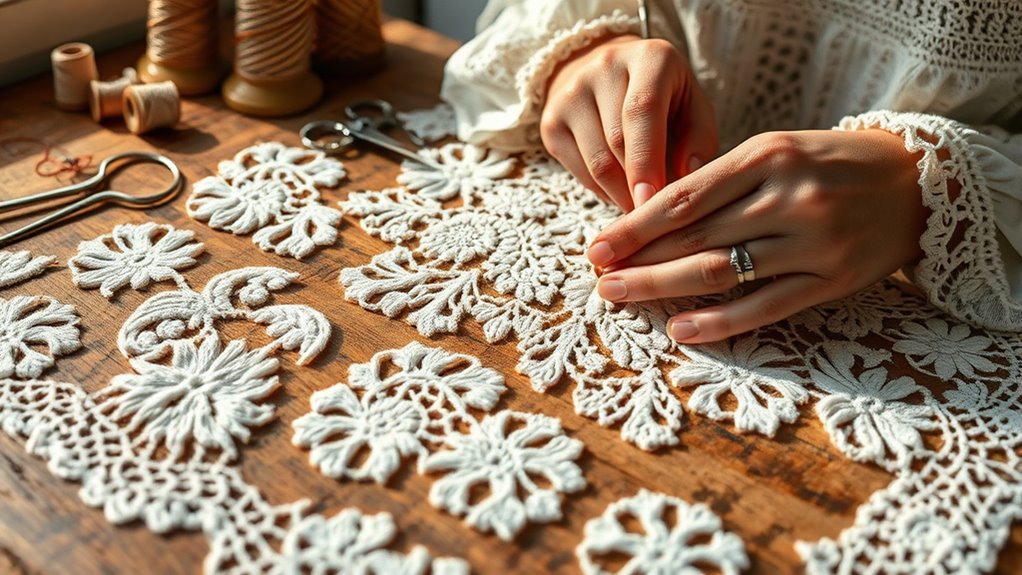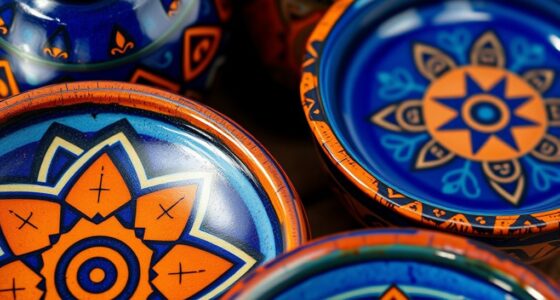To make Sardinian lace, you select natural linen or cotton threads and carefully prepare your design. Using tools like bobbins, needles, and a lace pillow, you work methodically, following traditional patterns to create intricate openwork designs. Techniques vary from bobbin lace to needle-based methods, often inspired by natural motifs or cultural symbols. If you want to discover the detailed steps and unique styles, there’s much more to explore about this centuries-old craft.
Key Takeaways
- Sardinian lace is traditionally handcrafted using linen or cotton threads, manipulated with needles, bobbins, and lace pillows.
- The process involves designing patterns, selecting appropriate threads, and carefully working through each stitch or knot.
- Techniques include bobbin lace (using bobbins and pins), needle lace (needle and buttonhole stitches), and reticella (geometric motifs with needlework).
- Natural dyes and motifs inspired by local flora, fauna, and folklore are often incorporated into the lace designs.
- Preservation relies on community workshops, artisan cooperatives, and cultural initiatives that teach and promote traditional Sardinian lace-making skills.
The Origins and Cultural Significance of Sardinian Lace

Sardinian lace has a rich history that dates back to the 16th century, rooted in Italy’s broader lace-making traditions found in Sicily, Venice, and Burano. Its origins are linked to practical crafts like fishermen’s net-making, which influenced local lace styles, especially in coastal towns like Bosa. Originally, coarse woven fabrics called buratto served household needs, but over time, they evolved into finer textiles used for decoration and religious purposes. Lace became a symbol of community identity, pride, and continuity, often passed down through women as family heirlooms or festive attire. It played a crucial role in Sardinian festivals and ceremonies, embodying resilience and cultural preservation. Today, Sardinian lace reflects a blend of practical craftsmanship and artistic expression, connecting generations through traditional techniques and regional symbolism.
Materials and Tools Used in Lace-Making
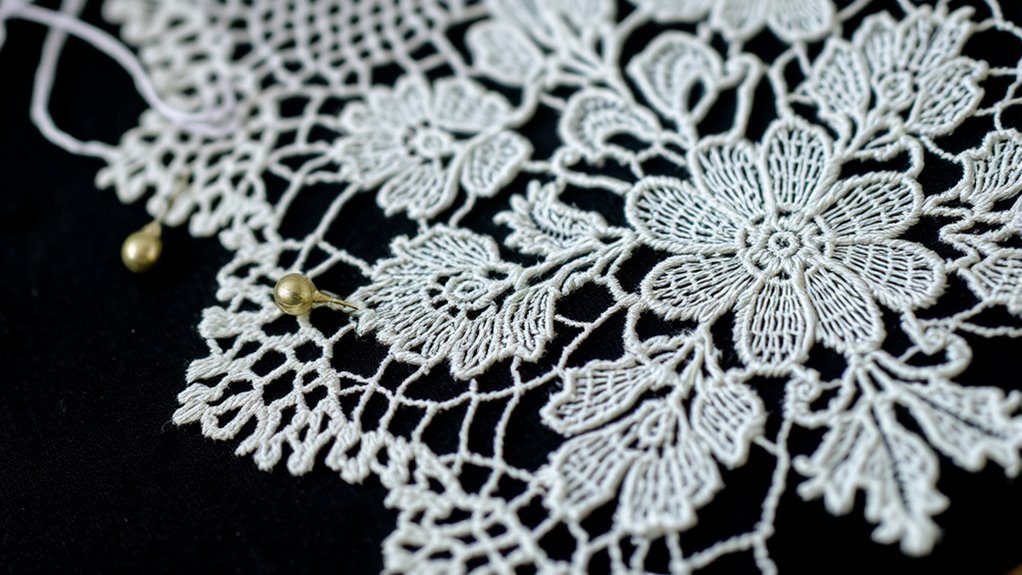
The materials and tools used in Sardinian lace-making are indispensable for creating the intricate patterns and fine textures that define this craft. You’ll primarily work with linen or cotton threads, prized for their durability and delicate feel. For specific lace types like Bosa Filet, loose-weave Buratto linen or Modano knotted netting serve as the base fabric. Sharp sewing needles of various sizes are crucial for needle lace techniques such as reticella, while bobbins made from wood or bone help manage multiple threads in bobbin lace. Wooden lace pillows provide a stable surface, and sets of decorated hardwood or bone bobbins enable complex weaving. Pins, fine needles, and specialized hooks assist with threading, placing beads, and fixing stitches, ensuring precise, beautiful results. High-quality pins and needles are essential for avoiding damage to delicate threads and achieving fine detail. Additionally, the selection of appropriate thread types and weights directly impacts the final appearance and intricacy of the lace.
Step-by-Step Process of Creating Sardinian Lace

Creating Sardinian lace begins with careful preparation of your workspace and tools. First, draw your design on paper or fabric to serve as a guide. Next, set up your surface with multiple layers for stability and secure your threads at the starting point. Choose your threads based on color and texture, guaranteeing they match your desired look. If using bobbin lace, hang the bobbins on pins, ready to be manipulated. Begin by making the first stitches, following your pattern precisely. Work through each row methodically, completing stitches and securing the lace with pins or stitches as needed. Use different stitch variations to add texture and detail. Finish your piece with buttonhole stitches or similar techniques, then inspect it carefully to ensure quality and consistency. Incorporating self-watering plant pots techniques can inspire innovative approaches to lace-making by emphasizing the importance of consistent moisture and careful monitoring during the process.
Distinctive Styles and Techniques of Sardinian Lace
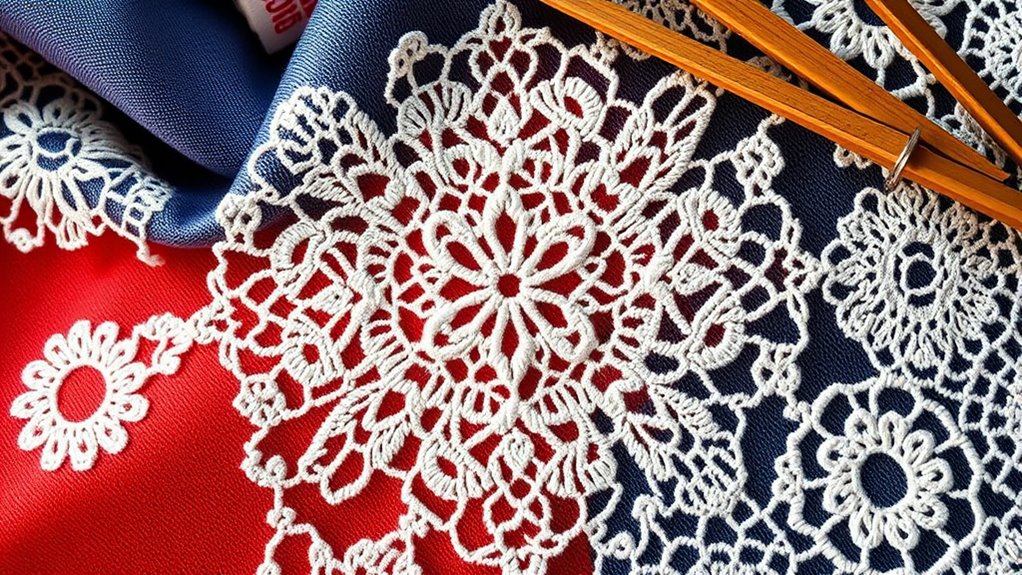
Distinctive styles and techniques define the rich diversity of Sardinian lace, reflecting both regional traditions and cultural influences. Bosa Filet Lace, originating from the fishing town of Bosa, features openwork geometric patterns created on loosely-woven linen or knotted netting. Its tight, single-thread technique, combined with knotting and embroidery, mimics fishing nets’ texture. In contrast, tatting uses a shuttle to produce delicate, decorative loops called picots, while reticella employs needle and button-hole stitches for geometric openwork structures. Both emphasize precision and fine detail. Traditional materials include local wool and linen threads, often dyed with natural herbs and lichens, maintaining a light, natural palette. These techniques showcase Sardinia’s craftsmanship, blending functional motifs with symbolic elements like filigree jewelry, to create intricate, culturally rich lace styles. Sardinian lace often incorporates motifs inspired by regional folklore and natural landscapes, further enriching its cultural significance. Additionally, the use of natural dyes ensures the preservation of traditional coloring methods and sustainable practices.
Preserving and Promoting This Traditional Craft
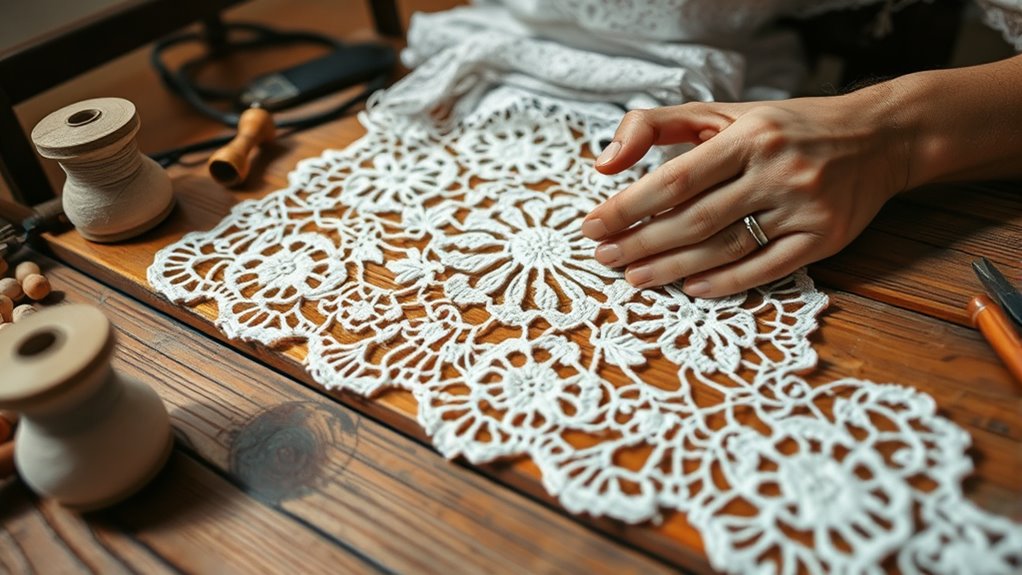
Preserving Sardinian lace requires a combination of community engagement, institutional support, and educational efforts that keep traditional techniques alive. Local artisan groups and cultural associations organize workshops and exhibitions, while municipalities in centers like Bosa and Samugheo provide funding and venues to showcase the craft. Museums dedicated to Sardinian textiles educate visitors and host demonstrations, helping to preserve knowledge. Collaborations with tourism offices promote cultural tourism centered on lace heritage, and participation in artisan fairs raises awareness and market value. Apprenticeship programs and craft schools transmit skills to younger generations, emphasizing both technique and cultural significance. Additionally, cooperatives and online platforms help artisans sell their work directly, ensuring economic viability. Efforts by local governments and cultural organizations play a crucial role in maintaining the tradition. These combined efforts sustain and revitalize Sardinian lace as a treasured cultural tradition. Furthermore, understanding the cultural importance of this craft encourages ongoing preservation and appreciation among new generations.
Frequently Asked Questions
How Long Does It Typically Take to Make a Piece of Sardinian Lace?
You’re curious about how long it takes to make Sardinian lace, but the time varies a lot. It depends on the complexity of the design and your skill level. If you’re experienced like Giovanna Ledda, you can work quickly, but beginners need more time. Since each piece is handcrafted with intricate stitches and precise tension, there’s no fixed duration. Patience and practice are key to mastering this beautiful craft.
Are There Specific Patterns or Motifs Unique to Sardinian Lace?
You might think all lace is delicate, but Sardinian lace stands out with its bold motifs. Unlike others, it features unique animal, mythical, and botanical patterns like gryphons, dragons, and intertwined trees. These motifs aren’t just decorative—they symbolize protection, fertility, and spirituality. Each region adds its own twist, making Sardinian lace a vibrant tapestry of cultural identity, blending tradition with artistry in every stitch.
Can Sardinian Lace Be Machine-Made or Is It Exclusively Handcrafted?
You might wonder if Sardinian lace can be machine-made. While technically possible, it’s primarily handcrafted because of its intricate stitches, delicate textures, and unique patterns. Machines struggle to replicate the precision, variability, and cultural authenticity that artisans achieve with needle and thread. This handcrafted process preserves Sardinian traditions and guarantees the lace’s value, making machine production rare and generally not considered authentic or true to the traditional craft.
What Are Common Challenges Faced by Artisans in Maintaining Traditional Techniques?
You face many challenges in maintaining traditional lace-making techniques. Limited access to authentic materials, aging artisans with physical difficulties, and a lack of interest from younger generations make it hard to pass down skills. Economic pressures and competition from mass-produced lace threaten the craft’s survival. Additionally, community support and proper documentation are often insufficient, risking the loss of intricate patterns and methods that define this beautiful, historic art form.
How Can Beginners Start Learning Sardinian Lace-Making Today?
To start learning Sardinian lace-making today, you should gather basic materials like fine needle and thread. Begin with simple stitches such as running and buttonhole stitch, using a pattern on a support cushion. Practice small samples to build your skills, and watch tutorials or read guides for step-by-step instructions. Join local or online groups for support, and focus on consistent practice to develop confidence and technique.
Conclusion
As you explore Sardinian lace, imagine weaving a delicate tapestry of history and tradition, each intricate stitch a thread connecting generations. By preserving these timeless techniques, you’re nurturing a vibrant garden of cultural beauty that blooms with every finished piece. Your hands become custodians of a treasured craft, ensuring its story continues to shimmer like sunlight on fine lace, whispering centuries of artistry into the future. Keep weaving, and let this exquisite heritage flourish.
